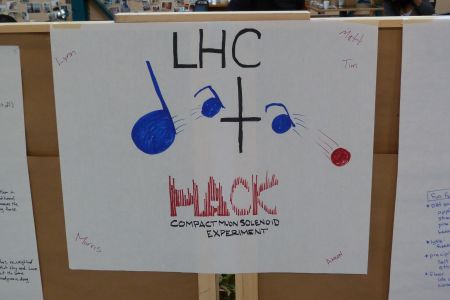
Recently I participated in my second Science Hack Day (SHD), in San Francisco in November 2011. What is a Science Hack Day, you ask? According to primary organiser Ariel Waldman: “The mission of Science Hack Day is to get excited and make things with science. A Hack Day is a 48-hour all-night event that brings together designers, developers, scientists and other geeks in the same physical space for a brief but intense period of collaboration, hacking, and building ‘cool stuff’.”
At this recent SHD you found groups hacking cell phones to operate as a distributed earthquake warning system, mixing up potable DNA cocktails, tracking the International Space Station on a modified desk globe, and simulating the cross-talk of sensory input that is synaesthesia. At my first SHD in Palo Alto in 2010, I brought data from the BaBar experiment that ran at SLAC from 1999-2008 and with the help of some enthusiastic volunteers, turned the detector information into sounds! We called this the Particle Physics Wind Chime, and after some more development in the months after, I turned it into a downloadable application complete with visual cues. I've used the Wind Chime as a hook for outreach efforts to explain what we (physicists) do.
This year, I was a bit more ambitious and wanted to see if I could enable enthusiastic amateurs to interface with high-energy physics data and perhaps do real science. At the very least, I hoped we would produce a cool outreach tool or two. CMS has made subsamples of the dataset available for education and outreach efforts and these data have been used in Masterclass events and in the I2U2 project, put together by the Quarknet team at FNAL. While I am not a CMS collaborator, I figured this would be an excellent test case to see if a generic particle physicist could provide an interface between these data and a very interested public. I had learned about these datasets from Kati Lassila-Perini, a CMS collaborator, at a recent Data Preservation in High Energy Physics (DPHEP) workshop. The DPHEP group is interested in finding solutions to enable HEP datasets to produce analysis and results long after the traditional lifetime of the experiment or collaboration. A primary interest of mine is encouraging the use of these datasets for education, outreach and training the next generation of particle physicists.
After a number of back-and-forth emails with two other CMS/Quarknet collaborators, Tom McCauley and Tom Jordan, I felt confident I could explain it to the hackers. At the Hack Day, there was considerable excitement and enthusiasm that I had brought with me “real LHC data”, even among those who wound up working on other hacks. Our group consisted of an economist, computer engineers from some local software companies, a computer science student from Kenya, an artist, and other interested hackers who drifted in and out of our circle over the weekend. Everyone was super bright, but it is still non-trivial to condense a scientific analysis that may take more than a year, down to a 24-hour hack.
In the end, our group chose to create two visualisations of parts of the analysis process, and embed them in a website that would explain the process to the general public.
We decided to focus on:
- Relativisitic kinematics and the idea that if you try to reconstruct parent particles using the classical mechanics that you learn in first-year physics, then the data is much less interesting. (Histograms: Takes a few seconds to load.)
- The process of calculating some quantity in the data (in our case the invariant mass of muon pairs) and filling a histogram to look for some structure. (Di-muon mass spectrum: Takes 15-30 seconds to load; move the slider at the top to the right to accumulate events quicker.)
In the end we just finished the projects and the site in the stipulated time. Unfortunately, you can see that we ran out of time in prettying up the site and links, but considering we hacked it together in about 24 hours, we were all quite proud of our efforts. At the final presentations of all the hacks, the SHD crowd were very interested in the visualisations. Though there was a bit of disappointment that our team had not found the Higgs. Oh well, maybe next year!
From my point of view, Science Hack Day is an excellent opportunity to interact with the public to whom we want to explain our work. I'm able to prototype and experiment with visuals and language with the very community that I want to engage. I also always wind up learning a lot from the more-professional computer programmers and designers who frequent these events. The hackers themselves learned a lot about science in general and high-energy physics in particular. I feel that I'm a virus who has benignly infected them with knowledge and enthusiasm about particle physics and the questions that we're trying to answer. Hopefully, they will go forth and spread this virus of enthusiasm as well! TV shows and public lectures are fantastic venues to explain our work, but we should not underestimate the power of engaging the public with the same data used in our own analyses.
— Submitted by Matt Bellis
- Log in to post comments

